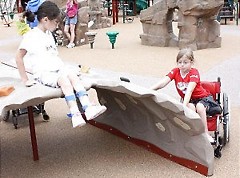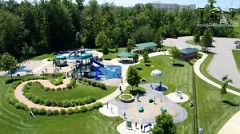According to the US Census, 12% of the population has a disability severe enough that it affects at least one function of daily living. Imagine all the mothers, fathers, siblings, grandparents, and friends who are involved in their daily lives. Realistically, one in three people in our country are impacted daily by disability. Currently, there is increased energy being directed toward how parks and playgrounds become places that not only provide better access to play, but truly enrich our whole community by becoming welcoming and inclusive places for all.
In the past few years, we’ve engaged several neighborhoods in planning efforts around improving their parks and playgrounds. We’ve seen an increased interest and demand for including a wider spectrum of disabilities during the design phase of parks and playgrounds. Communities are interested in moving beyond just meeting minimum standards for the Americans with Disabilities Act (ADA). While reducing barriers and improving access is a necessary step, it doesn’t speak to the greater potential of creating inclusive places that support all children and adults, regardless of physical and psychological situations, to come together to play, learn and grow.
Inclusive play opportunities benefit individuals and families with disabilities, they also benefit the community. At the playground, inclusion in play helps to reduce outdated social stigma and misconceptions, informs developing minds and encourages patience. Above all, when socialization through inclusive play occurs, it allows individuals with disabilities to be seen as more alike than different.
Unfortunately, in Grand Rapids we don’t have many playgrounds or parks that incorporate all of the design elements of inclusive play. A search of Boundless Playgrounds, an organization that helps communities design and build more inclusive playgrounds, only has two playgrounds listed in West Michigan- in Wyoming and Holland. In Grand Rapids’ city parks, we only have three park playgrounds that have unitary surfacing, Canal Park, Plaster Creek Family Park and the future Pleasant Park.
Obviously, cost is a major deterrent from building larger, more inclusive playgrounds. Multiple features, unitary surfacing, more intentional design and wider pathways are more expensive than a traditional, off-the-shelf playgrounds with wood fiber surfacing. A traditional playground typically costs around $100,000. An inclusive playground can cost nearly five times that amount. But our community has an opportunity to subscribe to a bolder vision of play and inclusion. We should be looking at how the community can build the partnerships and resources to support inclusive playgrounds in key areas of the city, and how existing playgrounds can take steps toward that goal.
The Rapidian, a program of the 501(c)3 nonprofit Community Media Center, relies on the community’s support to help cover the cost of training reporters and publishing content.
We need your help.
If each of our readers and content creators who values this community platform help support its creation and maintenance, The Rapidian can continue to educate and facilitate a conversation around issues for years to come.
Please support The Rapidian and make a contribution today.


